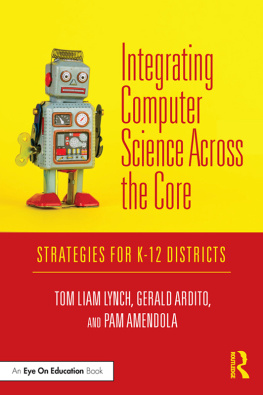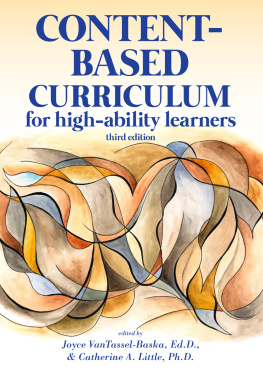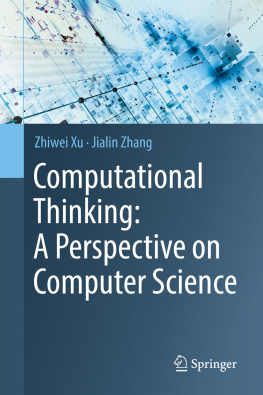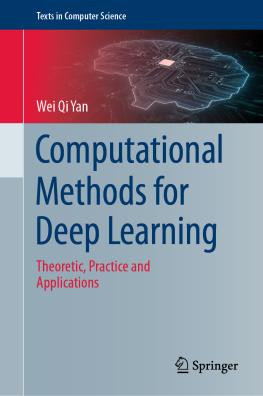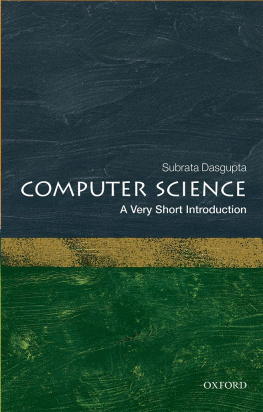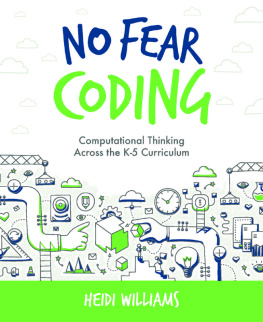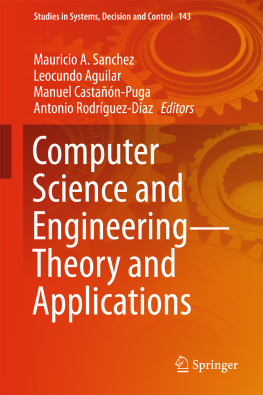
Integrating Computer Science
Across the Core: Strategies
for K12 Districts
Integrating Computer Science Across the Core is a guide to systematizing computer science and computational thinking practices in your school. While most books explain how to teach computer science as a stand-alone discipline, this innovative approach will help you leverage your existing curriculum to deepen and expand students' learning experiences in all content areas. Effective, equitable, and sustainable, this blueprint provides principals, curriculum directors, directors of technology, and other members of your school or district leadership team with suggested organizational structures, tips for professional learning, and key resources like planning instruments.
Tom Liam Lynch is Director of Education Policy at the Center for New York City Affairs and Editor-in-Chief of InsideSchools.org at The New School, USA, and a former education technology professor, English teacher, and school district official for the New York City Department of Education.
Gerald Ardito is Associate Professor of Computer Science Education at Manhattanville College, USA. He was previously a middle school science teacher and Assistant Professor of STEM-D Education at Pace University, USA.
Pam Amendola is an English teacher at Dawson County High School in Dawsonville, Georgia, and previously taught British and American literature at Brookwood High School in Snellville, Georgia, USA.
Tom Liam Lynch is director of education policy at the Center for New York City Affairs at The New School and editor-in-chief of InsideSchools.org. A former educational technology professor, English teacher, and school district official for the New York City Department of Education, Tom led the implementation of a $50-million online learning program in over one hundred schools called iLearnNYC. He then architected and co-piloted the implementation of WeTeachNYC, a $6.8-million digital resource repository, learning environment, and blended learning program for the city's 80,000 teachers. Tom's research examines the relationship between software theory, literacy, and education reform. He has published widely and presented the world over on educational technologies, school reform, and new literacies. In 2019, Tom received the National Technology Leadership Initiative Award from the National Council of Teachers of English (NCTE) for his development of both theory and methods for embedding computer science in K12 English classrooms. Learn more at tomliamlynch.com.
Gerald Ardito has been working in education for almost three decades. His experience includes adult education, adolescent biology, computer science, and, most recently, higher education. He is currently an associate professor of Computer Science Education at Manhattanville College, USA. He was previously a middle school science teacher and assistant professor of STEM-D education at Pace University, USA. His research interests include the development of self-directed, technology-enhanced learning environments and the development and deepening of computational thinking skills in K12 students.
Pam Amendola, EdS, has worked in education for seventeen years. Her experience includes teaching British and American literature, journalism, yearbook, and adult education. Prior to her current position at Dawson County High School in Dawsonville, Georgia, she had the pleasure of teaching many creative students at Brookwood High School. Her research interests include building literacy through computational thinking, creative use of AI in education, and transforming education for the Fourth Industrial Revolution.
First published 2020
by Routledge
52 Vanderbilt Avenue, New York, NY 10017
and by Routledge
2 Park Square, Milton Park, Abingdon, Oxon, OX14 4RN
Routledge is an imprint of the Taylor & Francis Group, an informa business
2020 Taylor & Francis
The right of Tom Liam Lynch, Gerald Ardito, and Pam Amendola to be identified as authors of this work has been asserted by them in accordance with sections 77 and 78 of the Copyright, Designs and Patents Act 1988.
All rights reserved. No part of this book may be reprinted or reproduced or utilised in any form or by any electronic, mechanical, or other means, now known or hereafter invented, including photocopying and recording, or in any information storage or retrieval system, without permission in writing from the publishers.
Trademark notice: Product or corporate names may be trademarks or registered trademarks, and are used only for identification and explanation without intent to infringe.
Library of Congress Cataloging-in-Publication Data
A catalog record for this title has been requested
ISBN: 978-0-367-19862-6 (hbk)
ISBN: 978-0-367-19864-0 (pbk)
ISBN: 978-0-429-24378-3 (ebk)
Typeset in Bembo
by Cenveo Publisher Services
We are grateful for the support of many colleagues, friends, and family who helped us throughout the writing of this book. We are indebted to Tony Picciano at the City University of New York, who fortuitously suggested to an editor at Routledge to talk with Tom about possible innovative directions the field might be going. That led Daniel Schwartz to meet with Tom and encourage the composition of this very book. So, Tony and Danthank you.
Tom would like to thank so many thought partners who have always been generous with their time and insights about K12 computationality. To Michael Preston at the Joan Gantz Cooney Center; Daniel Rabuzzi, Founder of Indigo Pheasant LLC and Tom O'Connell of MOUSE.org; the education team at Sam Houston State University: Hannah Gerber, Tori Hollas, and Christina Ellis; Aankit Patel, formerly of the NYC Department of Education and now with the City University of New York; Britt Neuhaus at the Overdeck Family Foundation; Viraj Kamdar at The Bill & Melinda Gates Foundation; Amber Oliver at the Robin Hood Foundation; Jason Jefferies at Blenderbox; and dear friend, early musician, and CS guru Hank Heijink. To all of you: big ups.
Gerald learned how to teach CS to students thanks to the kindness and engagement of colleagues and students. He especially wants to thank Lauren Scollins, a terrific and passionate colleague. Gerald also wants to thank Frank Williams and Raymond Tribble of the White Plains New York Youth Bureau and Gerald Dennis of the Northeast Starter STEM Academy at Mt. Vernon (NSSA) for granting him the privilege of working with the young people in their programs. Gerald only hopes that these students learned half as much from him as he did from them.
For Pam, the journey towards integrating CS concepts in the ELA classroom has been an adventure filled with mutual respect from her two co-authors, Dr. Tom Liam Lynch and Dr. Gerald Ardito. She is humbled that they included her to be a part of this project and is inspired by their tireless efforts to create new knowledge. They have been a true delight to collaborate with on common interests in building new literacies with computer science concepts. To Dr. Christy Desmet, may she rest in peace, for cultivating Pam's love of Shakespeare. To Kristen Fowler, for encouraging Pam to extend her teaching practice outside her comfort zone. To Chris Michael for his brilliant computer science guidance. And, most importantly, Pam is eternally grateful for her soulmate John Amendola, who has been her biggest advocate and most ardent supporter. His compassion for others is Pam's inspiration to be a better human every day.
We are tempted to assume that you think computer science is worth teaching in K12 settings. After all, you have opened a book about that very topic. It would be safe to think that you need little convincing. But people open books like this for different reasons. Sure, you yourself might have an intrinsic interest in coding or robotics or things like that. It is also possible that someone else asked (or told) you to read this book. We get it. No judgement either way.
Next page
